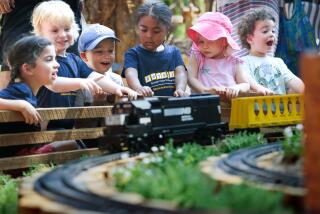Enter the Secret Garden : At Descanso, a world of green coolness awaits visitors, offering a retreat from the ills of urban life.
LA CANADA FLINTRIDGE — Above smog-laden Glendale, just moments from the roaring Foothill Freeway, lies a world of nothing but green coolness, bees, squirrels and flowers, ponds of gently floating ducks and bobbing fish--Descanso Gardens.
The gardens are open for escape from the city from 9 a.m. to 4:30 p.m. daily, except Christmas Day.
1 p.m.: Park in the large lot and enter though the gatehouse, picking up a map of the gardens and buying tickets at the information booth: $5 for adults, $3 for senior citizens or students with I.D., $1 for children 5 to 12, free for children younger than 5. With your admission, you get back one Descanso dollar, which can be used toward the $1.50 cost of a tram ticket or at the cafe, which offers sandwiches, salads, cool drinks and a patio to dine on.
The pleasant, 45-minute tram ride is a good introduction to the 165-acre sanctuary (65 acres of which are available to visitors). The land originally was the home, from the 1930s to ‘50s, of E. Manchester Boddy, founder of the long-defunct Los Angeles Daily News.
Although the guided loudspeaker tour doesn’t exactly fit in with the reflective ambience of the place, it is a good way to get an overview. Afterward, you can do your own walking tour of the areas that interest you.
1:45 p.m.: After the tram ride, the walking tour’s first stop is at the koi pond, where Japanese carp up to 20 inches long gracefully swim up to the bank. Visitors can feed the fish corn from a nearby vending machine, which dispenses kernels for a nickel. Adding to the genteel mood--an artist sits nearby with paints and canvas and, across the way, a couple in full wedding regalia pose for photographs under a vine-covered trellis.
2 p.m.: Next stop, the Japanese Tea House, surrounded by what a plaque describes as authentic vegetation supplied courtesy of the Japanese community. A tea-and-cookies menu was posted in the tea house, but no one was serving on a recent weekday. Nevertheless, the chairs and tables in this quiet, leafy retreat would make a perfect place to read, write, study or just think.
2:15 p.m.: A winding, leaf-strewn path through the Camellia Forest is overhung with tall oaks that let in just enough slender rays of sunlight to create a fairy-tale “Secret Garden” atmosphere and to make a visitor forget that this is a smoggy, muggy day everywhere else.
Only a few of the camellias were in bloom. They really get going in November and December and are at their peak in February. A return visit to see the acres of pink, white, yellow and red flowers this winter is a must. The path winds uphill to the Hospitality House, the big, white Colonial that was the Boddy residence. Now it’s an art gallery, featuring different artists from month to month.
On our visit, watercolors and pottery were on display and for sale--from $7 for a ceramic leaf to $1,250 for a large watercolor landscape. There’s also a small library in the house that is open to the public for reference use. Most of the books, not surprisingly, are about plants, flowers and the cultivation thereof.
2:45 p.m.: Continue along the paved walkway to the Chaparral Nature Trail, which leads uphill through an area of the gardens devoted to native California trees and shrubs, many of them endangered. Next to the trail entrance is a small glen of ferns, where the effect of the filtered light would inspire even the most inartistic visitor. Farther along the walkway is a thatched treehouse that was built as a set for the children’s TV series “Land of the Lost.”
3 p.m.: Walk by another pond, this one inhabited by zillions of tiny fish and guarded by a lone duck, which was singularly unimpressed with an offering of corn from another conveniently located vending machine. Next to the pond, a babbling waterfall and a bend from which to regard it.
3:15 p.m.: The Bird Observation Station is surrounded by perches covered in birdseed, but the only visitors on this day were, in odd combination, the turtles and black swans in the adjacent pond. The gardens’ ubiquitous squirrel population seemed to be taking most advantage of the birdseed bait. There are labeled pictures of birds on the wall so human visitors can identify any feathered ones.
3:30 p.m.: Next, turn back downhill toward the gatehouse and pass the construction site for the future International Rosarium, which will include a large pavilion and rose gardens. It is due to be completed by next spring at a cost of more than $1 million. (The gardens used to be operated by Los Angeles County, but now are run by a private guild.) The path back to the gatehouse is lined with flowering plants and another koi pond.
3:45 p.m.: Take a look in the gift shop, stocked with floral-motif gifts--ceramics, books, T-shirts, posters, not to mention plants and garden decorations.
More to Read
Sign up for The Wild
We’ll help you find the best places to hike, bike and run, as well as the perfect silent spots for meditation and yoga.
You may occasionally receive promotional content from the Los Angeles Times.






